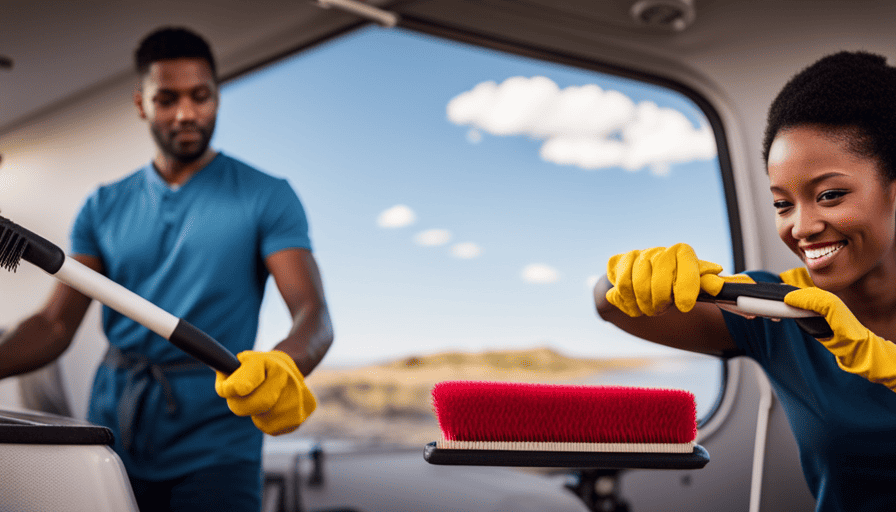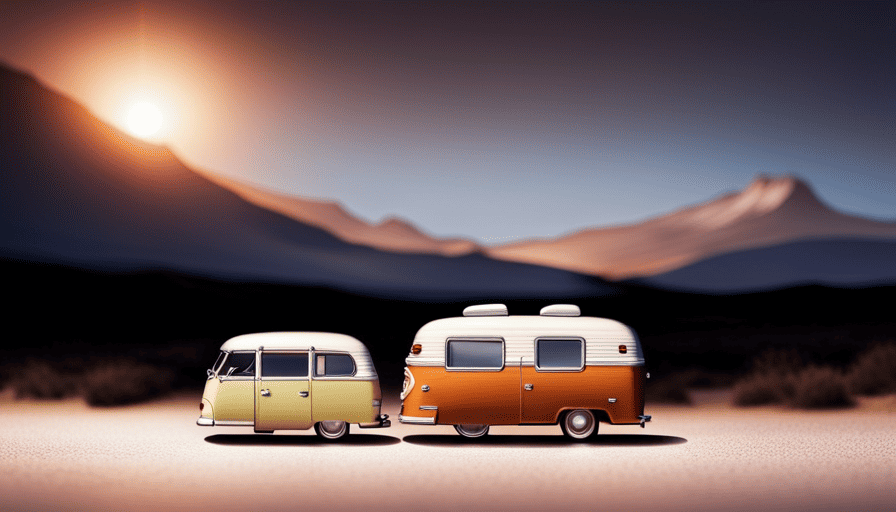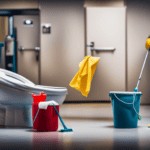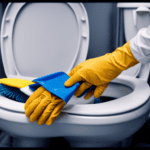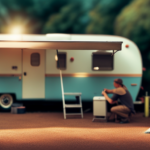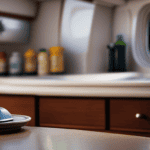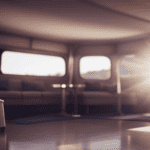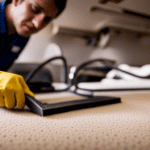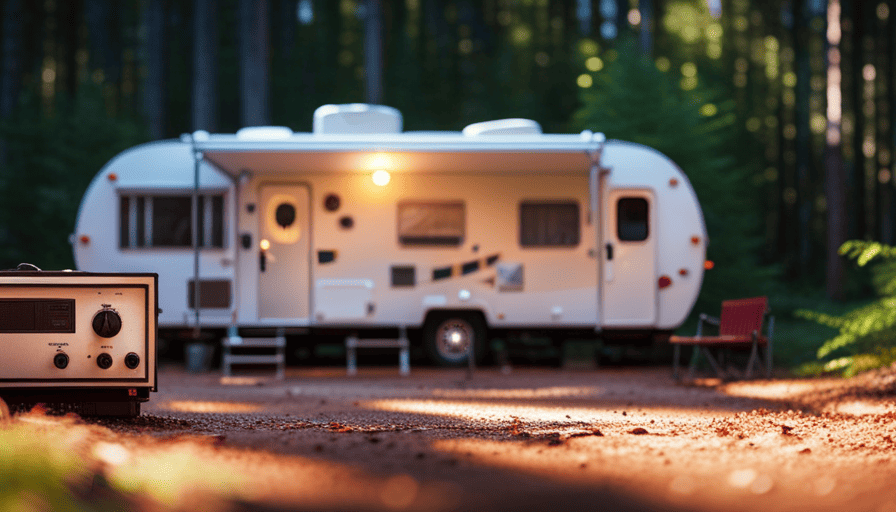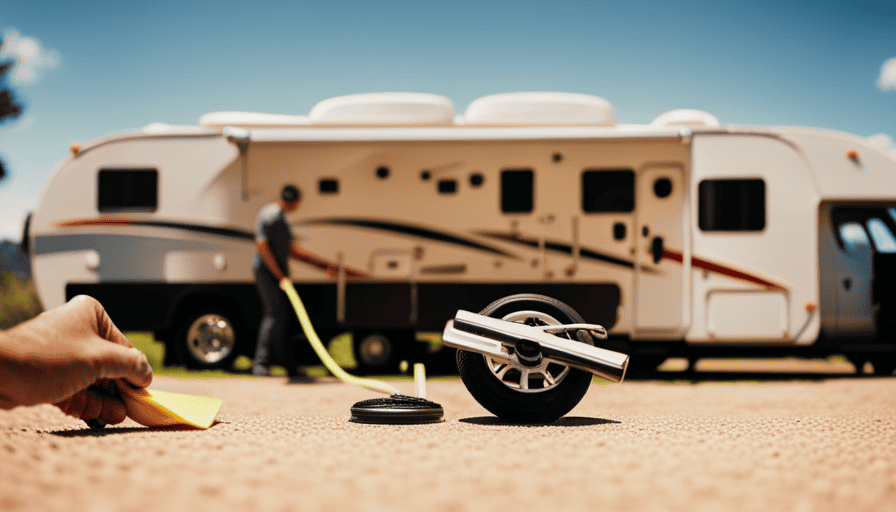Maintaining a pop-up camper with regular cleanings is crucial for preserving its excellent condition and guaranteeing a pleasant camping trip. Similar to other vehicles, it’s important to routinely clean and upkeep a pop-up camper to eliminate the build-up of dirt, dust, and filth that gathers with time.
In this article, I will guide you through the step-by-step process of cleaning your pop-up camper, from the exterior to the interior, beds, cushions, bathroom, and storage areas. By following these simple steps and maintaining regular cleaning habits, you can keep your camper looking fresh and smelling clean.
So, grab your cleaning supplies and let’s get started on transforming your pop-up camper into a sparkling haven for your next adventure. Remember, a clean camper is a happy camper!
Key Takeaways
- Regular cleaning and maintenance are necessary for maintaining the condition of a pop-up camper.
- Mold and mildew should be inspected and treated in all areas of the camper.
- Organize storage areas for easy access and declutter by removing unused items.
- Create a cleaning schedule and regularly sweep, vacuum, and wipe down surfaces to prevent dirt and grime buildup.
Gather Your Cleaning Supplies
Before you start, make sure you’ve got all your cleaning supplies ready to go. Cleaning a pop-up camper can be a bit of a chore, but with the right tools and know-how, it can be a breeze.
Here are some cleaning tips and essential cleaning products to get you started. First, gather all the necessary cleaning supplies. You’ll need a bucket, a hose with a spray nozzle, a scrub brush, a sponge, mild soap or detergent, window cleaner, paper towels, and a vacuum cleaner. These items will help you tackle all the different areas of your pop-up camper.
Start with the exterior. Begin by rinsing off any loose dirt or debris with the hose. Then, mix some mild soap or detergent with water in the bucket and use the scrub brush to clean the exterior surfaces. Pay special attention to any stubborn stains or grime. Rinse off the soap with the hose and dry the surfaces with a clean towel.
Now that the exterior is clean, it’s time to move on to the interior. Transitioning into the next section, let’s start by focusing on the main living area of the pop-up camper.
Start with the Exterior
To start cleaning the exterior of your pop up camper, begin by washing the surfaces thoroughly. Use a mild detergent or soap and water mixture to remove dirt and grime. Be sure to pay special attention to any stubborn stains or areas that may have accumulated dirt.
Next, clean the windows and screens using a glass cleaner and a soft cloth, making sure to reach all corners and edges.
Finally, scrub the awning with a mild cleaner and a brush, focusing on any stains or mildew that may have formed. Rinse all surfaces well and allow them to dry completely before moving on to the next step.
Wash the Exterior Surfaces
Scrubbing the exterior surfaces of your pop-up camper is like giving it a refreshing bath, revitalizing its appearance and washing away any dirt or grime. To begin, gather the necessary cleaning products such as a mild detergent and a soft brush or sponge. Fill a bucket with warm water and mix in the detergent according to the instructions.
Starting from the top and working your way down, dip the brush or sponge into the soapy water and gently scrub the surfaces. Pay extra attention to areas that are particularly dirty. Rinse the surfaces thoroughly with clean water, making sure to remove all soap residue. Finally, dry the exterior using a soft cloth or towel, ensuring that no moisture remains.
With the exterior surfaces clean and dry, it’s time to move on to the next step: cleaning the windows and screens.
Clean the Windows and Screens
Now that the exterior surfaces of your pop-up camper are sparkling, it’s time to give those windows and screens a much-needed shine. Start by gathering the necessary cleaning tools, such as a bucket, a squeegee, and a microfiber cloth.
For the cleaning solution, mix a few drops of mild dish soap with warm water in the bucket. Dip the squeegee into the soapy water and gently scrub the windows, making sure to remove any dirt or grime. Use the squeegee to remove the excess water, working from top to bottom in a sweeping motion.
Finally, use a microfiber cloth to dry and polish the windows for a streak-free finish. With the windows and screens gleaming, it’s time to move on to the next step: scrubbing the awning.
Scrub the Awning
Once your exterior surfaces are sparkling and your windows and screens are shining, it’s time to give your awning a thorough scrub. Cleaning the awning is an important step in maintaining its durability and ensuring its longevity.
Start by extending the awning fully, making sure it’s secure and stable. Use a broom or brush to remove any loose dirt and debris.
Fill a bucket with warm water and add a mild detergent. Dip a soft-bristle brush into the soapy water and gently scrub the awning, paying attention to any stains or spots. Rinse thoroughly with clean water and allow it to air dry completely before retracting it.
With the awning looking fresh and clean, it’s time to move to the interior and continue the cleaning process.
Move to the Interior
As you step into the pop-up camper, the cozy interior welcomes you with its warm, inviting atmosphere. The interior space of a pop-up camper may be compact, but with some cleaning tips and organizing tips, you can make it feel spacious and comfortable.
Here are a few steps to help you clean and organize the interior:
-
Start by removing any personal items or clutter from the camper. This will make it easier to clean and give you a fresh canvas to work with.
-
Use a handheld vacuum cleaner or a broom to remove any dirt, dust, or debris from the floors and corners of the camper.
-
Wipe down all surfaces, including countertops, tables, and cabinets, with a mild cleaning solution. Pay special attention to any sticky or greasy spots.
-
Clean the windows and mirrors using a glass cleaner and a soft cloth to ensure a streak-free shine.
With the interior of the pop-up camper sparkling clean and organized, it’s time to pay attention to the beds and cushions.
Pay Attention to the Beds and Cushions
Upon entering the cozy interior, make sure the beds and cushions are meticulously tended to. Cleaning the beds and cushions in your pop-up camper is essential for a comfortable and hygienic camping experience.
To start, remove all sheets, blankets, and pillowcases from the beds and set them aside for washing. Use a vacuum cleaner or handheld vacuum to thoroughly clean the mattresses and cushions, removing any dirt, dust, or crumbs. Pay special attention to the corners and crevices where debris tends to accumulate.
Next, mix a solution of mild soap and warm water, and gently scrub the mattresses and cushions with a soft brush or sponge. Rinse thoroughly with clean water and allow them to air dry completely before putting the bedding back on. This will help eliminate any odors and maintain the freshness of your sleeping area.
Don’t forget about the bathroom, where proper cleaning and maintenance are equally important for a pleasant camping experience.
Don’t Forget about the Bathroom
Now that we’ve taken care of the beds and cushions, let’s move on to another important area of the pop-up camper: the bathroom.
Keeping the bathroom clean is essential for a comfortable and odor-free camping experience. Here are a few tips to help you in this task.
First, start by removing any dirt or debris from the bathroom floor. Use a broom or handheld vacuum to get rid of any loose particles.
Next, wipe down the toilet, sink, and shower with a mild cleaning solution. Be sure to scrub any stains or buildup that may be present.
To prevent odors, it’s important to keep the bathroom well-ventilated. Open the windows or turn on the vent fan to allow fresh air to circulate. Additionally, empty the black water tank regularly and use a holding tank deodorizer to control odors.
Lastly, address any mold or mildew that may be present in the bathroom. Use a mixture of vinegar and water to scrub away any visible mold or mildew. Be sure to pay attention to corners, crevices, and shower curtains.
By following these bathroom cleaning tips and preventing odors, you’ll ensure a clean and fresh-smelling pop-up camper.
Now, let’s move on to the next section and address any mold or mildew that may be lurking in other areas of the camper.
Address any Mold or Mildew
To tackle any lurking mold or mildew, make sure to thoroughly inspect all areas of your camper. Start by checking the bathroom, as it’s a common area for mold and mildew to develop. Look for any signs of discoloration or a musty smell. If you spot any mold or mildew, take immediate action to prevent it from spreading and causing further damage.
Begin by removing any lingering odors by using a mold and mildew cleaner specifically designed for campers. Apply the cleaner to the affected areas and let it sit for a few minutes before scrubbing with a brush. Rinse thoroughly with water and dry completely.
To prevent future mold growth, make sure the bathroom is well-ventilated. Open windows or use a fan to circulate air and reduce humidity. Also, regularly clean and dry the bathroom after each use.
Once you’ve addressed any mold or mildew in the bathroom, it’s time to move on to the next step: clean and organize the storage areas.
Clean and Organize the Storage Areas
Take a moment to assess your storage areas, ensuring that they are well-maintained and efficiently organized for easy access to your belongings. When it comes to cleaning and organizing the storage areas in your pop-up camper, there are a few helpful tips and storage solutions that can make the process easier.
One of the first steps is to declutter your storage areas. Remove any items that you no longer need or use, and consider donating or selling them. This will create more space and make it easier to organize your belongings.
Next, clean the storage areas thoroughly. Wipe down the surfaces with a mild cleaner and ensure that they are dry before placing your belongings back inside. This will help prevent any mold or mildew from forming.
To maximize storage space, consider using storage bins or containers. These can help keep items organized and prevent them from shifting during travel. Label each bin or container with its contents to make it easier to find what you need.
Incorporating shelves or hanging organizers can also provide additional storage options. Utilize the walls and vertical spaces to make the most of the available space.
Cleaning and organizing the storage areas in your pop-up camper is essential for a well-maintained and efficient living space. By following these cleaning tips and utilizing storage solutions, you can ensure that your belongings are easily accessible and your camper stays tidy. Maintaining regular cleaning habits will help keep your storage areas in top shape.
Maintain Regular Cleaning Habits
When it comes to maintaining a clean pop-up camper, there are a few key habits that I always follow.
First, I make it a point to sweep and vacuum regularly to keep dirt and debris from piling up. This helps to prevent any potential damage to the flooring and keeps the space looking tidy.
Additionally, I always make sure to wipe down surfaces after use to remove any spills or stains, ensuring that everything stays fresh and clean.
Sweep and Vacuum Regularly
While going on your camping adventures, be sure to regularly sweep and vacuum your pop-up camper to keep it clean and free of dirt and debris. Regular maintenance is key in ensuring that your camper stays in good condition and is ready for your next trip.
Create a cleaning schedule that includes sweeping and vacuuming at least once a week or after each camping trip. Start by removing any loose items from the camper and opening all windows and vents to allow for proper ventilation. Use a broom or handheld vacuum to sweep the floors, paying special attention to corners and hard-to-reach areas.
Next, use a vacuum with a brush attachment to remove any dirt or dust from upholstery, curtains, and mattresses. Remember to wipe down surfaces after use to prevent the buildup of dirt and grime.
Wipe Down Surfaces After Use
Make sure to wipe down all surfaces after you’ve finished using them to keep your camper looking fresh and ready for your next adventure. Creating a cleaning schedule can help you stay on top of this task.
Start by removing any loose debris using a soft cloth or brush. Then, mix a solution of mild detergent and warm water and use it to wipe down countertops, tables, and other surfaces. Pay special attention to areas that come into contact with food, such as the kitchenette.
For sanitizing surfaces, use a disinfectant spray or wipes to kill any bacteria or germs. Don’t forget to wipe down the bathroom area as well.
Once you’ve finished cleaning, transition into the next section about storing your camper properly by making sure all surfaces are dry and ready for storage.
Store Your Camper Properly
To properly store your camper, there are two key points that I always make sure to follow.
First, empty and clean out the refrigerator to prevent any unpleasant odors or mold from developing during the storage period. Remove all food items, clean the shelves and drawers, and leave the refrigerator door slightly ajar to allow for air circulation.
Second, cover and protect the camper from the elements to prevent any damage. Use a breathable cover to keep out dust and debris, and consider using wheel covers to protect the tires.
Additionally, make sure to secure any loose items inside the camper to prevent shifting during storage.
Empty and Clean Out the Refrigerator
First things first, grab a sponge and get ready to give that refrigerator a sparkling makeover. Cleaning out and maintaining your camper’s refrigerator is an important step in keeping it in top shape. Here are some cleaning tips and refrigerator maintenance steps to follow:
-
Remove all food items from the refrigerator and discard any expired or spoiled items.
-
Mix a solution of warm water and mild dish soap in a bucket.
-
Dip the sponge into the soapy water and gently scrub the interior walls, shelves, and drawers of the refrigerator.
-
Rinse the sponge and wipe down the surfaces with clean water to remove any soap residue.
-
Finally, dry the refrigerator thoroughly with a clean cloth before restocking it with fresh food.
With your refrigerator sparkling clean and ready to go, it’s time to move on to the next step: covering and protecting the camper from the elements.
Cover and Protect the Camper from the Elements
Now it’s time to safeguard your camper from the elements by securely covering and protecting it. To ensure the longevity of your pop-up camper, it’s essential to invest in protective covers and employ weatherproofing techniques.
Start by purchasing a high-quality cover specifically designed for pop-up campers. These covers are made from durable materials that shield your camper from rain, snow, UV rays, and other harsh elements. Before covering, make sure your camper is clean and dry to prevent any moisture from getting trapped. Follow the manufacturer’s instructions to properly secure the cover, ensuring a snug fit.
Additionally, consider using weatherproofing techniques such as sealing windows and doors with weatherstripping and applying a protective coating to the exterior.
By taking these measures, you can protect your camper from damage caused by the elements and enjoy your clean and fresh pop-up camper without any worries.
Enjoy Your Clean and Fresh Pop-Up Camper
After the hard work of cleaning your pop-up camper, you’ll be able to kick back and fully appreciate the refreshing and inviting atmosphere. But before you can relax, there are a few steps you should take to ensure that your camper stays clean and fresh.
First, make sure to keep up with regular maintenance. This includes regularly inspecting and cleaning the canvas, checking for any signs of wear or damage, and repairing any issues promptly. By staying on top of these tasks, you can prevent any potential problems from arising and keep your camper in top condition.
Another important aspect of maintaining a clean and fresh pop-up camper is preventing odors. One simple way to do this is by using air fresheners or odor absorbers throughout the camper. You can also open up the windows and doors to let in fresh air whenever possible.
Additionally, be mindful of what you bring into the camper. Avoid storing or leaving any food or garbage inside, as this can quickly lead to unpleasant odors. Instead, dispose of waste properly and make sure to clean up any spills or messes right away.
By following these steps and incorporating regular maintenance and odor prevention into your routine, you can enjoy a clean and fresh pop-up camper every time you hit the road.
Frequently Asked Questions
How often should I clean my pop-up camper?
I find that deep cleaning my pop-up camper at least once a year is sufficient. However, if you frequently use it or if it’s exposed to harsh weather conditions, you may want to clean it more often.
Here are some cleaning tips and tricks to make the process easier:
1) Start by removing all personal items and furniture.
2) Vacuum and sweep the interior thoroughly.
3) Use mild soap, water, and a soft brush to clean the surfaces.
4) Don’t forget to clean the exterior and check for any leaks or damage.
5) Finally, make sure to dry everything properly before storing it.
Can I use regular household cleaning products on the exterior of my camper?
Yes, you can absolutely use regular household cleaning products on the exterior of your camper. They work wonders in removing dirt, grime, and other stubborn stains.
However, if you’re looking for alternative cleaning solutions, there are some natural options available as well. For example, a mixture of vinegar and water can be used to clean the exterior surfaces effectively. Just be sure to rinse thoroughly afterwards to avoid any residue.
What is the best way to remove stubborn stains from the beds and cushions?
To remove stubborn stains from pop up camper beds and cushions, there are some effective methods you can try.
Start by vacuuming the surface to remove any loose dirt. Then, mix a solution of warm water and mild detergent. Gently scrub the stained area using a soft brush or sponge. Rinse with clean water and blot dry.
For tougher stains, you can use a stain remover specifically designed for upholstery. Always test on a small, hidden area first to ensure it won’t damage the fabric.
How can I prevent mold and mildew from forming in my pop-up camper?
To prevent mold and mildew from forming in my pop-up camper, I take proactive steps. Firstly, I ensure proper ventilation by opening windows and vents to prevent condensation buildup.
Secondly, after each use, I thoroughly dry out the camper, paying special attention to areas prone to moisture, like the bathroom and kitchen.
By following these simple steps, I can maintain a clean and mold-free environment in my pop-up camper.
Are there any specific cleaning products I should use for the bathroom in my pop-up camper?
When it comes to cleaning the bathroom in my pop-up camper, I highly recommend using specific bathroom cleaning products. These products are designed to effectively clean and sanitize bathroom surfaces, such as the toilet, sink, and shower. Some popular options include bathroom cleaners with bleach or antibacterial properties.
However, if you prefer alternative cleaning options, you can also use a mixture of vinegar and water or baking soda to clean and disinfect the bathroom area.
Conclusion
In conclusion, cleaning a pop-up camper is essential for maintaining its longevity and ensuring a comfortable camping experience. By following the steps outlined in this article, you can easily keep your camper clean and fresh.
Did you know that, according to a survey, 80% of campers reported feeling more relaxed and at ease when their camping equipment is clean? Taking the time to clean your pop-up camper not only extends its lifespan but also enhances your overall camping experience. So, don’t forget to regularly clean and maintain your camper for a stress-free adventure!

